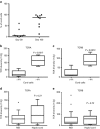Quantitative characterization of T-cell repertoire in allogeneic hematopoietic stem cell transplant recipients
- PMID: 26052909
- PMCID: PMC4559843
- DOI: 10.1038/bmt.2015.133
Quantitative characterization of T-cell repertoire in allogeneic hematopoietic stem cell transplant recipients
Abstract
Allogeneic hematopoietic stem cell transplantation (HSCT) is one of curative treatment options for patients with hematologic malignancies. Although GVHD mediated by the donor's T lymphocytes remains the most challenging toxicity of allo-HSCT, graft-versus-leukemia (GVL) effect targeting leukemic cells, has an important role in affecting the overall outcome of patients with AML. Here we comprehensively characterized the TCR repertoire in patients who underwent matched donor or haplo-cord HSCT using next-generation sequencing approach. Our study defines the functional kinetics of each TCRA and TCRB clone, and changes in T-cell diversity (with identification of CDR3 sequences) and the extent of clonal expansion of certain T-cells. Using this approach, our study demonstrates that higher percentage of cord-blood cells at 30 days after transplant was correlated with higher diversity of TCR repertoire, implicating the role of cord-chimerism in enhancing immune recovery. Importantly, we found that GVHD and relapse, exclusive of each other, were correlated with lower TCR repertoire diversity and expansion of certain T-cell clones. Our results highlight novel insights into the balance between GVHD and GVL effect, suggesting that higher diversity early after transplant possibly implies lower risks of both GVHD and relapse following the HSCT transplantation.
Figures




References
-
- Copelan EA. Hematopoietic stem-cell transplantation. N Engl J Med. 2006;354:1813–1826. - PubMed
-
- van Besien K. Allogeneic transplantation for AML and MDS: GVL versus GVHD and disease recurrence. Hematology Am Soc Hematol Educ Program. 2013;2013:56–62. - PubMed
-
- Gustafsson Jernberg A, Remberger M, Ringdén O, Winiarski J. Graft-versus-leukaemia effect in children: chronic GVHD has a significant impact on relapse and survival. Bone Marrow Transplant. 2003;31:175–181. - PubMed
-
- Shlomchik WD. Graft-versus-host-disease. Nat Rev Immunol. 2007;7:340–352. - PubMed
Publication types
MeSH terms
Substances
Grants and funding
LinkOut - more resources
Full Text Sources
Other Literature Sources
Medical

